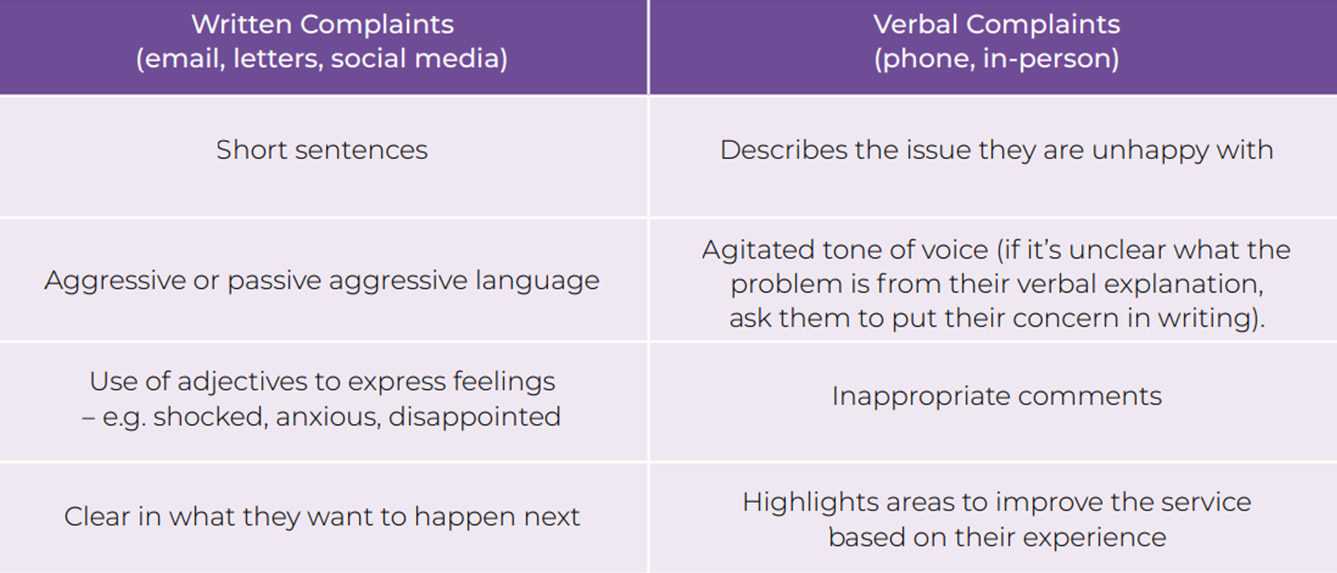How to Handle Aggressive Complaints in the Public Sector
 Chloe Martin
·
5 minute read
Chloe Martin
·
5 minute read
Dealing with aggressive complaints can feel like walking on eggshells, but there’s potential for positive outcomes from handling them effectively.
Uncovering the root cause of an aggressive complaint is a powerful way to understand users’ needs and where to make changes.
In this post, we’ll cover how to spot an aggressive complaint, best practices for communicating with an aggressive person and 10 tips for handling aggressive complaints in the public sector.
Jump Straight to:
- How to Spot an Aggressive Complaint - Verbal and Written
- How do You Communicate with an Aggressive Person?
- What Not to Say in Response to an Aggressive Complaint
- How to Handle Aggressive Complaints in the Public Sector | 10 Ways
- Where to Learn More Complaint Handling Insights
How to Spot an Aggressive Complaint – Verbal and Written
Just because someone doesn’t explicitly say they’re making a complaint, doesn’t mean they are not.
Spotting a written complaint is becoming harder with the growing ways users can complain – from social media to traditional complaint letters.
Not to worry. We’ve created a simple table to help you spot when someone might be making a complaint verbally or written.
How to Spot Different Types of Complaints
Written Complaints (email, letters, social media)
- Short sentences
- Aggressive or passive-aggressive language
- Use of adjectives to express feelings – e.g. shocked, anxious, disappointed
- Clear in what they want to happen next
Learn more about effectively responding to written complaints specifically.
Verbal Complaints (phone, in-person)
- Describes the issue they are unhappy with
- The agitated tone of voice (Ask them to put their concern in writing if their verbal explanation is unclear)
- Inappropriate comments
- Highlights areas to improve the service based on their experience
There are many potential complaint opportunities in the public sector which can be shown through this Complaints Maze. Try to map out your organisation's complaint routes to avoid missing key complaints.
How Do You Communicate with an Aggressive Person?
An aggressive complaint can lead to potentially aggressive situations, especially when face-to-face. The first step is to listen. If you try to resolve anger with anger, the situation is only likely to get worse. To reach a resolution, find out why the complainant is frustrated and then work out what the next best steps are.
Take your time to respond to what they've said. If you show you’re in a hurry or don’t have time, the complainant may feel even more frustrated with the situation.
Although most of the time complainants will be angry about a situation, or service they received, it can be helpful to understand the different types of anger.
Three Different Types of Anger:
-
Passive-aggressive: An indirect way of showing anger or frustration through sarcastic comments or remarks.
-
Inward anger: Anger towards yourself through negative self-talk which can lead to self-isolation.
-
Outward anger: Expressed towards an object or person through shouting.
There are many more specific types of anger that fit into these three types, for example:
- Fear-based anger
- Chronic anger
- Psychological anger
But, as long as you have an idea of the three main types, you can start to understand more about why a person is feeling this way.
If you’re dealing with aggressive verbal complaints regularly, take the time to look after yourself and your mental health. Take breaks, remember to breathe and remain calm as much as you can.
What Not to Say in Response to an Aggressive Complaint:
- Please calm down
- I don’t think this is my fault
- That’s not my responsibility/job
- We can’t help with that today
- There’s nothing I can do about that
- That’s just our policy
- I’m not sure
- You’re wrong
- It’s not a big deal
- If you had done…
How to Handle Aggressive Complaints in the Public Sector | 10 Ways
1. Be receptive and honest
Being receptive and honest when dealing with verbal complaints is crucial for effective resolution and maintaining positive relationships with complainants. It's important to create a safe space for the complainant to express their grievances.
Being receptive also means refraining from becoming defensive or argumentative. Instead of immediately providing explanations or justifications, focus on understanding the root cause of the complaint. Ask open-ended questions to gather more information and gain a deeper understanding of the complainant's perspective.
2. Use a distraction
Anger is such a strong emotion that it can overcome us very quickly. Distracting an angry person can help refocus their thoughts and maybe even reflect on their behaviour at that moment. Use this strategy in verbal situations to interrupt thoughts, not show the person that their anger isn’t justified or their feelings are invalid.
3. Explain limits and rules
Allowing insults, threats or emotions to affect you compromises your authority and lowers the chance of resolving the situation peacefully. Calmly explain that no member of staff will tolerate aggressive behaviour in any given situation. For example, say “I’m willing to listen, but if you need to stop shouting at me.”
4. Be respectful
It's natural to adopt the behaviour of those around you and it takes discipline to remain calm in the face of aggression. Speak in a clear, calm manner to give the complainant a single point of focus and time to process the information. This can help diffuse the situation. The one goal when verbally de-escalating a service user is to decrease agitation and prevent further problems.
5. Empathise with feelings, not behaviours
The complainant is making the time to complain for a reason. Although this can bring some aggressive behaviours, it’s important to try and understand why they’re feeling this way. This will give you a greater insight into what they would like to gain out of the complaint.
6. Listen
If someone is aggressive towards you, ask them to explain how they feel and what they mean to show you're listening. It's hard to be aggressive towards someone if they ask how you feel. Use active listening to truly understand the complainant, not just respond because you have to.
7. Be self-aware
In-person aggressive verbal complaints can be overwhelming and stressful. Be self-aware of how your body language comes across and ensure you’re not threatening the complainant unintentionally. Keep your body language open, use enough eye contact to show you’re listening and keep any movements you make calm.
8. Apologise if you or the organisation are at fault
Accountability is a key part of responding to complaints. If you know that you or the organisation is at fault, own up to this and apologise for the error. An apology takes responsibility and shows you’ll look into the issue or take action to avoid it in the future.
What if they don’t accept the apology? Continue to calm their emotions and ensure them that you will aim to find a solution that makes things right. Complainants may not always accept your apology, and that could mean they need more time to process the outcome.
9. Build trust by showing responsibility
A complaint means a potential mistake on your organisation's behalf. Either way, it's up to you to show how you're going to look into it. Show that you’re capable of understanding and helping them. If you do investigate the matter, get back in touch with the complainant to reignite their trust in your service.
10. Understand it’s not personal towards you
Most complaints to public sector organisations are not personal – they are aimed towards a disagreement of service, treatment etc. Often, anger is triggered by:
- Stress or a stressful situation
- Feeling frustrated
- Unfair treatment
- Feeling attacked or disrespected
- An underlying mental health condition
It’s understandable to feel overwhelmed after dealing with an angry or aggressive verbal complaint. Create space between you and the emotions you have absorbed during the day. Speak to your manager if you continue to feel impacted.
Discover More Complaint Handling Insights with our Free Handbook
Public services need constant improvement. Listen, handle and respond to complaints effectively to make service improvements. Use our Complaint Handling Handbook to gain more insights and tips.
Access your copy by clicking on the button below.
2+ years in SEO and content marketing. Striving to help public sector professionals develop their skills and learn something new through high-quality content.


%20verbal%20complaints.jpg?width=800&height=550&name=1%20(2)%20verbal%20complaints.jpg)






